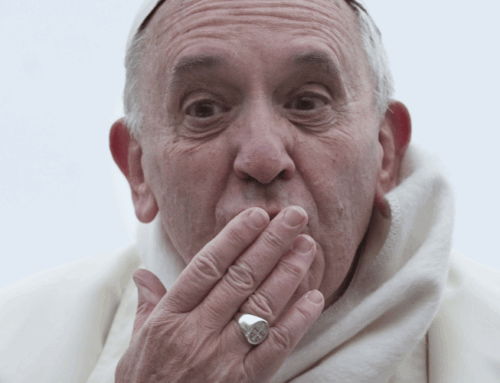At this time of home sheltering where public Masses and church gatherings of all kinds have been shut down, a deeper appreciation of the domestic church is emerging. Teresa Pirola reflects on the implications.
Like family ZOOM gatherings, there is something to be said for parishioners coming together online as Mass is celebrated. Many attest to finding solace and meaning in ‘virtual’ Mass attendance. There have also been thoughtful reflections on the meaning of ‘presence’, and technology’s capacity to aid eucharistic communion in a time of ‘absence’.
These perspectives have something important to say and deserve serious consideration, in view of the Eucharist as ‘the source and summit of the Christian life’ (CCC, 1324).
That said, my own eucharistic instincts seek a different ecclesial response to the COVID-19 crisis.
Whatever the merits of live-streaming Mass as a means of spiritual support, one would hope that it does not become the dominant pastoral response to this crisis. A congregation-less Mass viewed remotely by a lay ‘audience’ seems contrary to the very participatory nature of the liturgy with its deep incarnational instincts.
Rather, in response to the alienating effects of ‘social distancing’, more than ever we need to find appropriate ways to embrace the gospel as intimate, ‘enfleshed’ presence, proclaiming ‘what we have heard, what we have seen with our eyes, what we have looked at and touched with our hands, concerning the word of life’ (1 Jn 1:1).
And where better to concentrate this focus than on the life of the domestic church and its home-based spirituality?
A summons to the communion of ‘breaking bread’ at the family meal table (including all its moments of spilt milk, toddler tantrums, and sibling arguments) is more urgent, more direct, more incarnational, and ultimately more sacramentally fruitful, than drawing families to an inaccessible altar viewed on a TV or computer screen.
Think about it: we are living through a moment in history when, in every parish and diocese around the world, the domestic space is the only place where most Catholics can be fully present to one another in celebrating their Catholic traditions. In fact, the terrible necessity of enforced home isolation has opened up an extraordinary opportunity: to call the faithful—family units of every kind and configuration—to rediscover their power to ‘be’ church, each within their unique domestic context.
The resounding message from our ecclesial leadership, surely, has to be:
Our public worship places are closed, but now is the time for our lay faithful to step up. Your home is a holy place; you are ‘priest’ in your own home; your meal table is your ‘altar’; your family is the church in miniature, the ‘domestic church’, which, like the universal church, has all the marks of a priestly, prophetic calling to embody the reign of God.
Put simply, by St John Paul II: ‘Family, become what you are!’
Family as the Domestic Church
The idea of family as the ‘domestic church’ is part of our biblical and patristic heritage and was reaffirmed at Vatican II (LG, 11; cf. Acts 2:46, Rom 16:5, and the writings of John Chrysostom).
Today, in the time of coronavirus, we have an unprecedented opportunity to ‘grow’ the church in its most basic ecclesial experience: marital intimacy, parental love, family relationships and the domestic space—the primary place where we practise what it means to love, serve, forgive and pray.
Compared to the virtual experience of ‘watching’ Mass on a screen, the relational exchanges within the home (in all their joys, hopes, grief and anguish) are a more direct ecclesial participation and a tangible, embodied presence—all woven into the very fabric of our sacramental life as Catholics.
With the onset of the pandemic, we have seen a wonderful explosion of home-based spirituality resources from pastoral and education agencies. Now is the time for the ecclesial leadership to name and capitalise upon this phenomenon:
This is the hour of the domestic church! Families, lay faithful, lead the way! Show us how to do this. Leave your mark on our parishes and dioceses. Shift our ground to a more familial base; free us from clinging to the clericalist ways of the past.
To borrow a line from Pope Francis, ‘So what are we waiting for?’ (EG, 120).
It is time to move beyond the initial crisis management period (with its focus on the provision of online Masses), to intentional lay empowerment. Our conversations can be less about the pros and cons of ‘virtual’ Mass attendance and ‘private Mass’, and more filled with talk of ‘home-based spirituality’ and topics such as:
- meal table rituals
- everyday holiness
- simplified lifestyle
- family prayer and home-based festivities
- household innovation
- couple/parent leadership
- ways to talk with our teenagers about faith
- finding God in a messy house
- stories from the saints at home
- loving your spouse under lock-down pressures
- making peace with your ‘ex’
- gospel dating tips during coronavirus
- praying your way through another day of home-based schooling
. . . and so on.
In other words, this pandemic is a significant moment to rediscover the church’s familial heart. (This familial heart includes, of course, family members who are singles, celibates, and one-person households!)
The call of Vatican II
It is 56 years since Vatican II called forth the mission of the ‘domestic church’ (LG, 11); it is 39 years since Pope John Paul II summoned families to their ‘original’, ‘irreplaceable’, and ‘formidable’ role in transforming society (FC, 43); and four years since Pope Francis’ shared the fruits of a double-synodal pastoral focus on the family (Amoris Laetitia).
Further, it is nearly two millennia since the Jewish people rose from the ashes of their destroyed Temple (70 CE), with the strategic realisation that their very survival as a people depended on home-based religious practice, especially the Passover seder and the weekly Sabbath meal.
There is no questioning the centrality of Sunday Eucharist in our Catholic tradition; but when Mass dominates to the point of relegating the sacramentality of family life to a secondary focus, or attempting to transfer worship practices that belong in the parish church to the family living room, then we have lost something both precious and essential to our very understanding of what it means to be a eucharistic people.
As they say, ‘Never waste a crisis’. Coronavirus will have a grip for some time. Just as our nation requires a long-term economic strategy, our church requires a long-term spiritual strategy. What kind of faith community do we want at the end of all this, and how will we get there?
Within the crisis lies an opportunity: to name, affirm and unleash the hidden ecclesial energies of our families and domestic dwellings. If we do, we will emerge as a church strengthened at its very roots.
Clergy-centred strategies such as online Masses have their place as stop-gap measures, but that is all they can be. They may see us through a crisis, but inevitably they will lead us back to ‘business as usual’. Has there ever been a better time to make the homes of the Christian faithful a major ecclesial priority?
Teresa Pirola is a Sydney-based faith educator.
Home-based spirituality resources:
- Faith At Home (Broken Bay Diocese, Community of Catholic Schools)
- Walking the Way e-Bulletins (Parent Formation, CSO Broken Bay)
- The Messy Parenting Project
- The Family Dinner Project (Harvard Graduate School of Education)
- Young Catholic Mums
- Catholic Mom
- A Spirituality of Parenting Article by Fr Ron Rolheiser
- Universalis (Readings of the Day, Liturgy of the Hours)
- The Daily Examen (Ignatian Spirituality)
- Twenty Ways to Share Scripture at Home (Parent tips – CSO Broken Bay Diocese)
- CathFamily (Making the Home the Heart of the Church)






